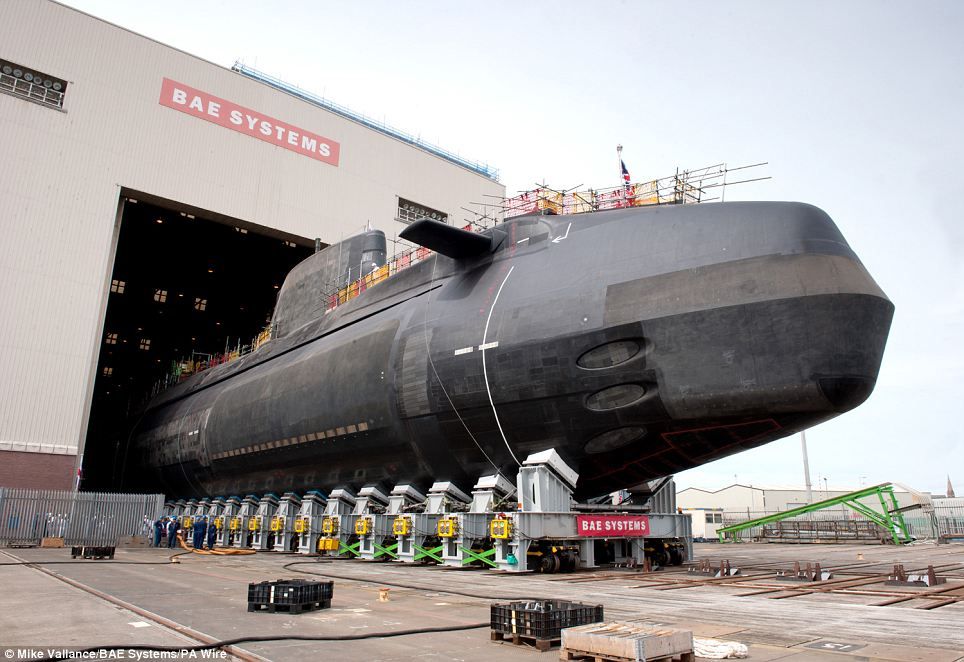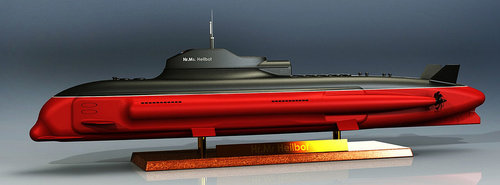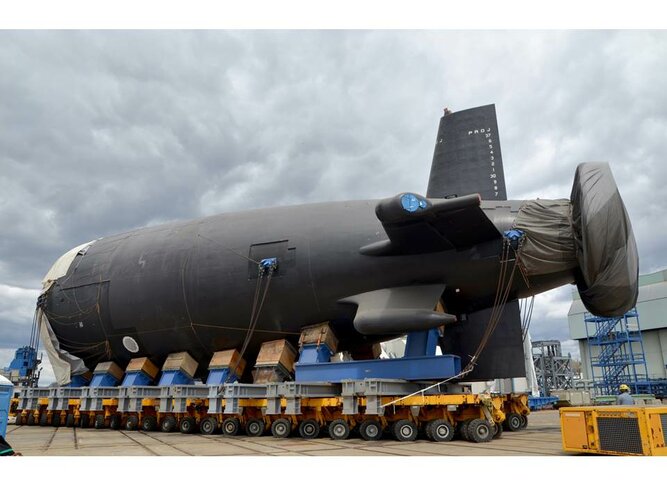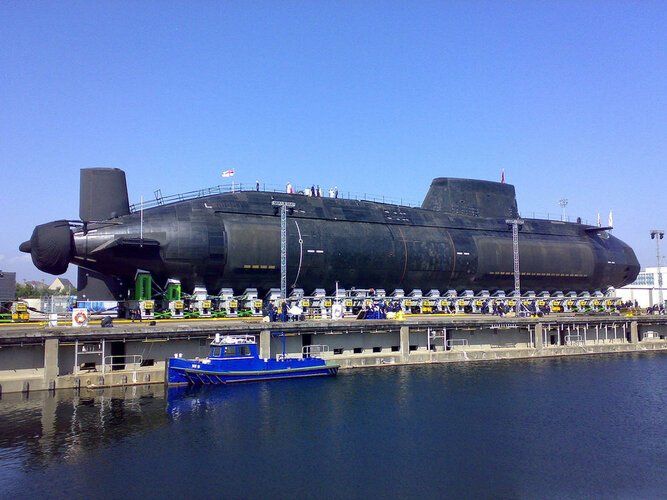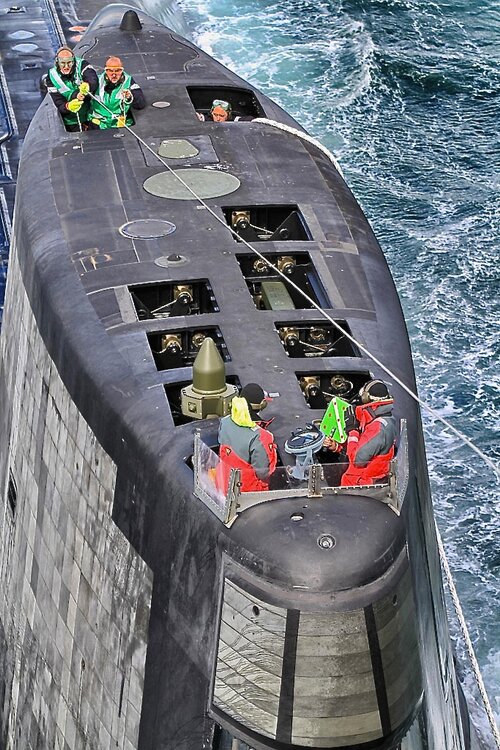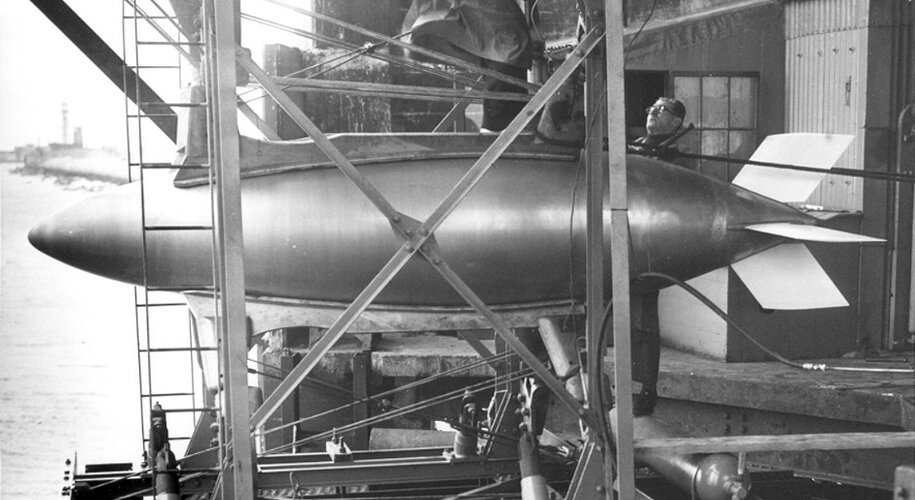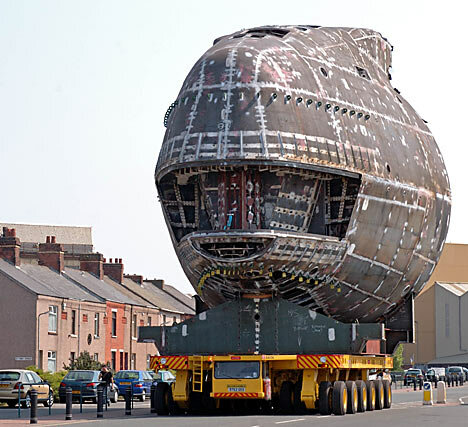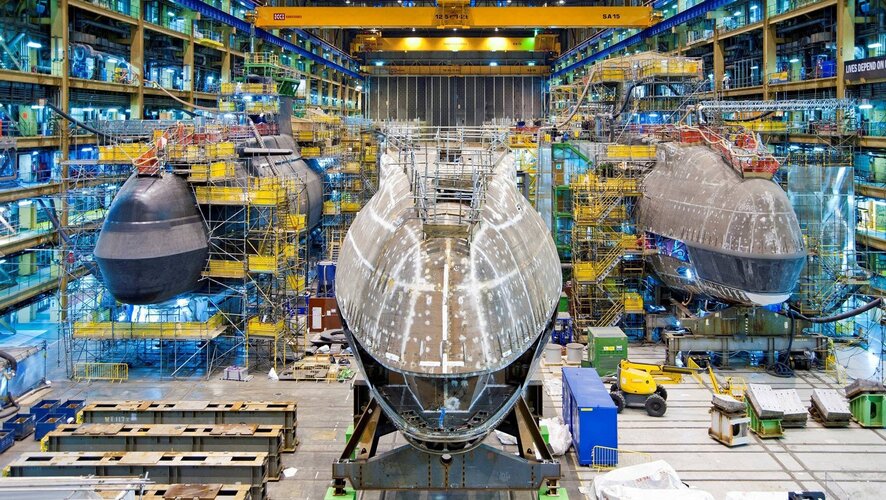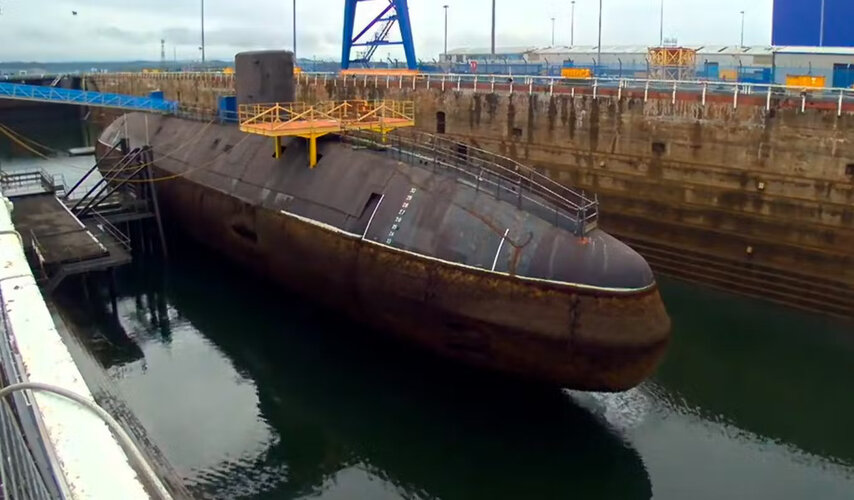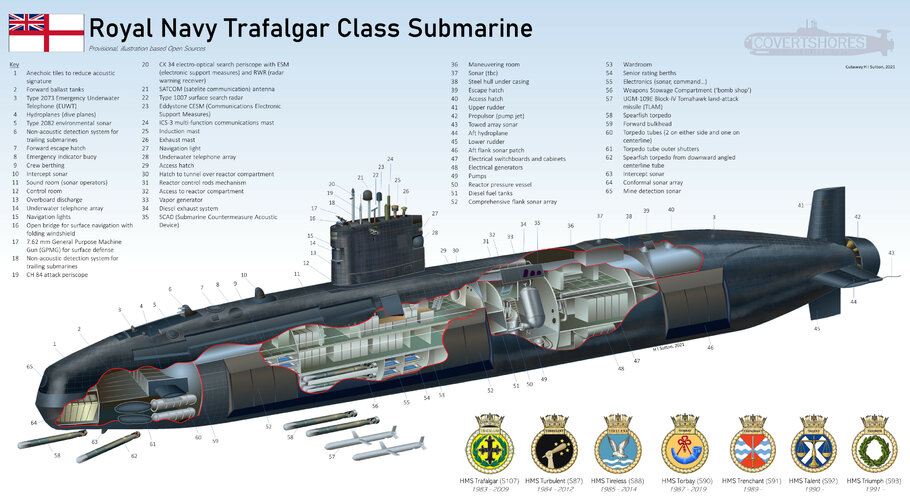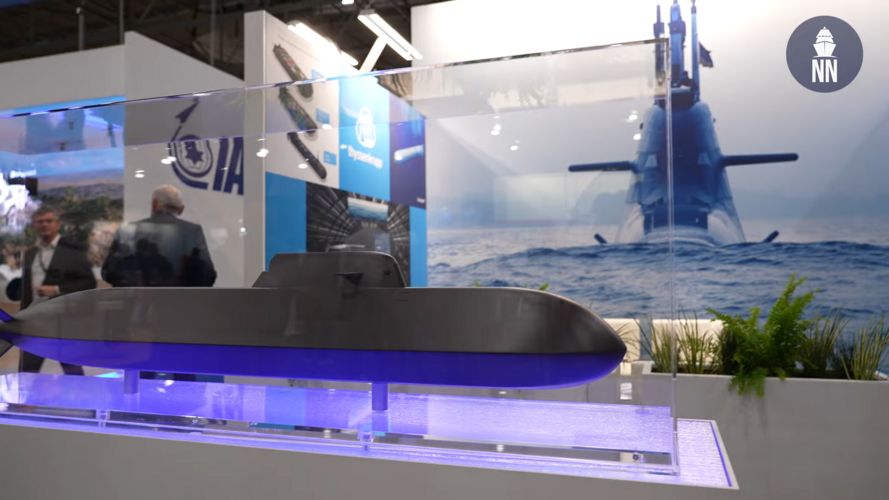You are using an out of date browser. It may not display this or other websites correctly.
You should upgrade or use an alternative browser.
You should upgrade or use an alternative browser.
Astute submarine
- Thread starter Ronny
- Start date
- Joined
- 19 July 2016
- Messages
- 4,287
- Reaction score
- 3,466
I mean modern submarine mostly have the cylinder water drop shape, astute has very strange noseNormal submarine? What is that?
- Joined
- 19 July 2016
- Messages
- 4,287
- Reaction score
- 3,466
These things evolve all the time I think the teardrop shape is going out of fashion for a while, apart from possibly high speed types.
I highly doubt that, among the modern submarine, only Astute doesn't have the tear drop shape I think.These things evolve all the time I think the teardrop shape is going out of fashion for a while, apart from possibly high speed types.
- Joined
- 4 July 2010
- Messages
- 2,516
- Reaction score
- 3,097
American SSNs use a large composite fairing over the bow which is optimally shaped for smooth flow at speed. The bow sonar(s) sit inside this fairing, and the steel starts with the bulkhead behind that sonar. Both the large spherical sonars used before Virginia block III and the more modern arrays, therefore, make some compromises to the bow's need for streamlining. Royal Navy SSNs are steel all the way out to the bow, the sonars are arranged in arrays which sit in "windows" set in the steel structure. These arrays cannot (affordably) accommodate complex curves like those required for a USN-style bow, and the RN doesn't want to set them within a large composite fairing like the USN uses. So, the bow they use is their solution to get optimal sonar performance while streamlining as much as possible.
In very broad strokes, the RN claims their compromise results in better sonar performance, especially at low speed, while the USN claims better hydrodynamic performance and less sonar degradation at higher speeds. The comparative real-world performance of the two navies sonars is the sort of thing you'll only find in the classified realm.
In very broad strokes, the RN claims their compromise results in better sonar performance, especially at low speed, while the USN claims better hydrodynamic performance and less sonar degradation at higher speeds. The comparative real-world performance of the two navies sonars is the sort of thing you'll only find in the classified realm.
Last edited:
Flying Sorcerer
ACCESS: Confidential
- Joined
- 18 June 2008
- Messages
- 129
- Reaction score
- 97
What is that?Normal submarine? What is that?
Thank you, this is the kind of answer I was looking for.American SSNs use a large composite fairing over the bow which is optimally shaped for smooth flow at speed. The bow sonar(s) sit inside this fairing, and the steel starts with the bulkhead behind that sonar. Both the large spherical sonars used before Virginia block III and the more modern arrays, therefore, make some compromises to the bow's need for streamlining. Royal Navy SSNs are steel all the way out to the bow, the sonars are arranged in arrays which sit in "windows" set in the steel structure. These arrays cannot (affordably) accommodate complex curves like those required for a USN-style bow, and the RN doesn't want to set them within a large composite fairing like the USN uses. So, the bow they use is their solution to get optimal sonar performance while streamlining as much as possible.
In very broad strokes, the RN claims their compromise results in better sonar performance, especially at low speed, while the USN claims better hydrodynamic performance and less sonar degradation at higher speeds. The comparative real-world performance of the two navies sonars is the sort of thing you'll only find in the classified realm.
- Joined
- 19 July 2016
- Messages
- 4,287
- Reaction score
- 3,466
I highly doubt that, among the modern submarine, only Astute doesn't have the tear drop shape I think.These things evolve all the time I think the teardrop shape is going out of fashion for a while, apart from possibly high speed types.
Just pointing out that we are not at the final form of the submarine and more 'different' designs are likely to crop up.
- Joined
- 19 July 2016
- Messages
- 4,287
- Reaction score
- 3,466
What is that?Normal submarine? What is that?
Something from grabcad, illustrating the concept that design does not stand still.
- Joined
- 6 September 2006
- Messages
- 4,838
- Reaction score
- 9,481
The shape goes back to the Swiftsure class, the Astutes just having a refined and very noticeable form of it. Doubtless a lot of work would have been done at the testing tanks at Haslar.
- Joined
- 19 July 2016
- Messages
- 4,287
- Reaction score
- 3,466
With what we paid for it, I do hope so.........
I am not sure I understand the explanation above. But let me try to rephrase it, to see if I got it:
So, US subs use a bow shape optimize for speed.
That shape can be achieved only with composite bow, if one wants a sonar of sufficient size.
British subs don't use that shape as the composite bow is too expensive for them. (really? in the context of a multi billion dollar sub? How much is the composite bow then, half a billion?)
British subs then use a smaller sonar, which resides in the lower half of the bow. So only that lower half cover is composite, while the upper section is metal.
Somehow the british bow shape is better for sonar performance at lower speed. (How?) Is the visible chine the reason for that?
At the same time old russian subs had a similar solution to Astute, with lower half of the bow being for sonar.
Newer russian subs have more similar bows to US subs, with torpedo tubes moved to the side and sonar cover accounting for the most of the bow.
Yet no russian sub have the chine.
No other (non british) sub in the world has the chine.
I am failing to see the connections here - just how is the speed and sonar influencing the decision to include a chine?
So, US subs use a bow shape optimize for speed.
That shape can be achieved only with composite bow, if one wants a sonar of sufficient size.
British subs don't use that shape as the composite bow is too expensive for them. (really? in the context of a multi billion dollar sub? How much is the composite bow then, half a billion?)
British subs then use a smaller sonar, which resides in the lower half of the bow. So only that lower half cover is composite, while the upper section is metal.
Somehow the british bow shape is better for sonar performance at lower speed. (How?) Is the visible chine the reason for that?
At the same time old russian subs had a similar solution to Astute, with lower half of the bow being for sonar.
Newer russian subs have more similar bows to US subs, with torpedo tubes moved to the side and sonar cover accounting for the most of the bow.
Yet no russian sub have the chine.
No other (non british) sub in the world has the chine.
I am failing to see the connections here - just how is the speed and sonar influencing the decision to include a chine?
- Joined
- 6 September 2006
- Messages
- 4,838
- Reaction score
- 9,481
Some speculations here: https://www.boatdesign.net/threads/bow-chines-uk-astute-class-submarines.50505/
Conclusion: nobody really knows, there is probably a hydrodynamic benefit of some kind as a trade-off from the layout imposed by the sonar configuration.
Conclusion: nobody really knows, there is probably a hydrodynamic benefit of some kind as a trade-off from the layout imposed by the sonar configuration.
Another thing to remember with British boats is that they tend to be more specialized for Arctic and ASW missions, they’re willing to settle for a shorter design service life vis a vis cost, and, particular to the Astute, they had to design an attack boat around a missile boat reactor.
Similarly, while the Virginia class can (technically) do (some) Arctic missions, it doesn’t have a hardened sail and is more limited in that respect compared to its predecessors. Here’s a 2013 summary on some Virginia class testing they did on Arctic and special warfare capabilities. Given that what I’ve read in more recent years has the Seawolves playing around in the Arctic I’m guessing a renewed emphasis on Arctic and UUV capability is why SSN(X) resembles Seawolf.
What I’m trying to get at is a given design can vary greatly depending on mission profile, design service life, and external cost and political factors.
Similarly, while the Virginia class can (technically) do (some) Arctic missions, it doesn’t have a hardened sail and is more limited in that respect compared to its predecessors. Here’s a 2013 summary on some Virginia class testing they did on Arctic and special warfare capabilities. Given that what I’ve read in more recent years has the Seawolves playing around in the Arctic I’m guessing a renewed emphasis on Arctic and UUV capability is why SSN(X) resembles Seawolf.
What I’m trying to get at is a given design can vary greatly depending on mission profile, design service life, and external cost and political factors.
Attachments
I've been wondering about this too and think Moose could be onto something, but I'm not certain.
Yes, more specifically for smooth flow around the sonar dome at high speed, resulting in less degradation of sonar performance in this regime.
No. As you say, legacy Russian subs have long adopted a similar axisymmetrical bow shape that, as on their British counterparts, is steel apart from the composite sonar windows. So that's not the problem.
No, cost isn't the obstacle, very strong emphasis on good sonar performance at low speeds is claimed to be.
Flow noise is less of a concern in this regime, perhaps making refractive distortion from a non-optimal sonar dome geometry relatively the more pressing consideration. The sonar window on Astute appears to be single-curvature while an axisymmetric dome would obviously be double-curvature. Now, unless the surface of the sonar can match the window shape however, the distance between it and the window, as well as the thickness of the window material traversed by the sound waves, is not uniform in all directions.
At this point it is worth noting that the bow sonar array configuration hitherto employed by US, Russian and British subs is different. Russian SSNs used to be fitted with cylindrical or conical bow sonars, US submarines famously adopted spherical arrays whereas British sonars were always what is known as conformal arrays. This latter technology has now also been adopted by the LAB sonar for the Block III Virginia-class and possibly all but the first (which has a US-style spherical array) Russian Severodvinsk-SSNs, following its introduction in the Lada-class SSK. There is potentially a significant difference though: both the US LAB and the Russian Lira sonar surfaces are double-curvature, while based on the sonar window the British arrays may well be single-curvature (two inclined planar panels joined by a cone frustum section at the forward end). This simplification could explain why the British were able to go down this route so early, at the cost of having a rather unorthodox bow shape forced upon them to make it work. Now that such arrays can be successfully implemented with double-curvature surfaces and therefore made to conform to favourable high-speed bow geometries, the US and Russia (having previously baulked at the shaping restrictions) are adopting this solution too. The British meanwhile, for cost reasons, are sticking with a bow configuration that has served them well enough for decades.
The one outlier which doesn't quite fit into this picture is the British Vanguard-class SSBN with its axisymmetrical bow. A surprising departure from convention (given that high speed is less relevant for nuclear deterrence role) and if it has a double-curvature conformal sonar why wasn't this technology later adopted for Astute?
A long winded way of saying I don't bloody know either, I guess
So, US subs use a bow shape optimize for speed.
Yes, more specifically for smooth flow around the sonar dome at high speed, resulting in less degradation of sonar performance in this regime.
That shape can be achieved only with composite bow, if one wants a sonar of sufficient size.
No. As you say, legacy Russian subs have long adopted a similar axisymmetrical bow shape that, as on their British counterparts, is steel apart from the composite sonar windows. So that's not the problem.
British subs don't use that shape as the composite bow is too expensive for them.
No, cost isn't the obstacle, very strong emphasis on good sonar performance at low speeds is claimed to be.
Somehow the british bow shape is better for sonar performance at lower speed. (How?) Is the visible chine the reason for that?
Flow noise is less of a concern in this regime, perhaps making refractive distortion from a non-optimal sonar dome geometry relatively the more pressing consideration. The sonar window on Astute appears to be single-curvature while an axisymmetric dome would obviously be double-curvature. Now, unless the surface of the sonar can match the window shape however, the distance between it and the window, as well as the thickness of the window material traversed by the sound waves, is not uniform in all directions.
At this point it is worth noting that the bow sonar array configuration hitherto employed by US, Russian and British subs is different. Russian SSNs used to be fitted with cylindrical or conical bow sonars, US submarines famously adopted spherical arrays whereas British sonars were always what is known as conformal arrays. This latter technology has now also been adopted by the LAB sonar for the Block III Virginia-class and possibly all but the first (which has a US-style spherical array) Russian Severodvinsk-SSNs, following its introduction in the Lada-class SSK. There is potentially a significant difference though: both the US LAB and the Russian Lira sonar surfaces are double-curvature, while based on the sonar window the British arrays may well be single-curvature (two inclined planar panels joined by a cone frustum section at the forward end). This simplification could explain why the British were able to go down this route so early, at the cost of having a rather unorthodox bow shape forced upon them to make it work. Now that such arrays can be successfully implemented with double-curvature surfaces and therefore made to conform to favourable high-speed bow geometries, the US and Russia (having previously baulked at the shaping restrictions) are adopting this solution too. The British meanwhile, for cost reasons, are sticking with a bow configuration that has served them well enough for decades.
The one outlier which doesn't quite fit into this picture is the British Vanguard-class SSBN with its axisymmetrical bow. A surprising departure from convention (given that high speed is less relevant for nuclear deterrence role) and if it has a double-curvature conformal sonar why wasn't this technology later adopted for Astute?
A long winded way of saying I don't bloody know either, I guess
- Joined
- 4 July 2010
- Messages
- 2,516
- Reaction score
- 3,097
The Vanguard bow is something of a hybrid, and is unique to the class' sonar suite. It's closer to an American-style bow than is usual, I don't know enough about RN internal workings to say why they went that way rather than following their usual practice, but it seems unlikely they will do so again.
Forest Green
ACCESS: Above Top Secret
- Joined
- 11 June 2019
- Messages
- 9,543
- Reaction score
- 17,523
More complex than the early 90’s Frankenstein of an American/Soviet ISS with cabling the length of Barrow to Faslane and an obsolete 25 year design life reactor that will leak and produce remediation challenges for decades of engineers to (over)come. I mean…slow clap??
Forest Green
ACCESS: Above Top Secret
- Joined
- 11 June 2019
- Messages
- 9,543
- Reaction score
- 17,523
Based on what exactly?
Amazing, have you tried offering your expertise in nuclear reactor design to the Royal Navy? I'm sure they'd be thrilled to have you.More complex than the early 90’s Frankenstein of an American/Soviet ISS with cabling the length of Barrow to Faslane and an obsolete 25 year design life reactor that will leak and produce remediation challenges for decades of engineers to (over)come. I mean…slow clap??
SSBN wont be planning to use active sonar, unless its really buggered things up.I've been wondering about this too and think Moose could be onto something, but I'm not certain.
So, US subs use a bow shape optimize for speed.
Yes, more specifically for smooth flow around the sonar dome at high speed, resulting in less degradation of sonar performance in this regime.
That shape can be achieved only with composite bow, if one wants a sonar of sufficient size.
No. As you say, legacy Russian subs have long adopted a similar axisymmetrical bow shape that, as on their British counterparts, is steel apart from the composite sonar windows. So that's not the problem.
British subs don't use that shape as the composite bow is too expensive for them.
No, cost isn't the obstacle, very strong emphasis on good sonar performance at low speeds is claimed to be.
Somehow the british bow shape is better for sonar performance at lower speed. (How?) Is the visible chine the reason for that?
Flow noise is less of a concern in this regime, perhaps making refractive distortion from a non-optimal sonar dome geometry relatively the more pressing consideration. The sonar window on Astute appears to be single-curvature while an axisymmetric dome would obviously be double-curvature. Now, unless the surface of the sonar can match the window shape however, the distance between it and the window, as well as the thickness of the window material traversed by the sound waves, is not uniform in all directions.
At this point it is worth noting that the bow sonar array configuration hitherto employed by US, Russian and British subs is different. Russian SSNs used to be fitted with cylindrical or conical bow sonars, US submarines famously adopted spherical arrays whereas British sonars were always what is known as conformal arrays. This latter technology has now also been adopted by the LAB sonar for the Block III Virginia-class and possibly all but the first (which has a US-style spherical array) Russian Severodvinsk-SSNs, following its introduction in the Lada-class SSK. There is potentially a significant difference though: both the US LAB and the Russian Lira sonar surfaces are double-curvature, while based on the sonar window the British arrays may well be single-curvature (two inclined planar panels joined by a cone frustum section at the forward end). This simplification could explain why the British were able to go down this route so early, at the cost of having a rather unorthodox bow shape forced upon them to make it work. Now that such arrays can be successfully implemented with double-curvature surfaces and therefore made to conform to favourable high-speed bow geometries, the US and Russia (having previously baulked at the shaping restrictions) are adopting this solution too. The British meanwhile, for cost reasons, are sticking with a bow configuration that has served them well enough for decades.
The one outlier which doesn't quite fit into this picture is the British Vanguard-class SSBN with its axisymmetrical bow. A surprising departure from convention (given that high speed is less relevant for nuclear deterrence role) and if it has a double-curvature conformal sonar why wasn't this technology later adopted for Astute?
A long winded way of saying I don't bloody know either, I guess
The MOD’s own analysis:Based on what exactly?
Again…read attached document.Amazing, have you tried offering your expertise in nuclear reactor design to the Royal Navy? I'm sure they'd be thrilled to have you.More complex than the early 90’s Frankenstein of an American/Soviet ISS with cabling the length of Barrow to Faslane and an obsolete 25 year design life reactor that will leak and produce remediation challenges for decades of engineers to (over)come. I mean…slow clap??
Attachments
I just read it. The vast majority of relevant information is blacked out, and what little we can read regarding leaks pertains to possible, not certain leaks in the primary cirquit.The MOD’s own analysis:Based on what exactly?
Again…read attached document.Amazing, have you tried offering your expertise in nuclear reactor design to the Royal Navy? I'm sure they'd be thrilled to have you.More complex than the early 90’s Frankenstein of an American/Soviet ISS with cabling the length of Barrow to Faslane and an obsolete 25 year design life reactor that will leak and produce remediation challenges for decades of engineers to (over)come. I mean…slow clap??
This is a risk assesment, not a crystal ball. Nowhere does it state that catastrophic leaks are inevitable, only that in case OF, the current reactor design and operations fall behind Relevant Good Practice as exemplified by USN and certain civilian standards.
Remediation challenges are... not inevitable. Again, that's a risk assesment; if the risk is deemed small, no remidiation will take place. The current reactor design was deemed sufficient to the standards of the RN as they stood when it was designed.
Also, your remark regarding "More complex than the early 90’s Frankenstein of an American/Soviet ISS with cabling the length of Barrow to Faslane", is... useless? I'm quite sure that complexity goes for ALL nuclear submarines, and likewise the cable length is nothing special. A 747 has on average 140 miles of cabling in it, do you think that's overly complex?
- Joined
- 9 October 2009
- Messages
- 21,979
- Reaction score
- 13,645
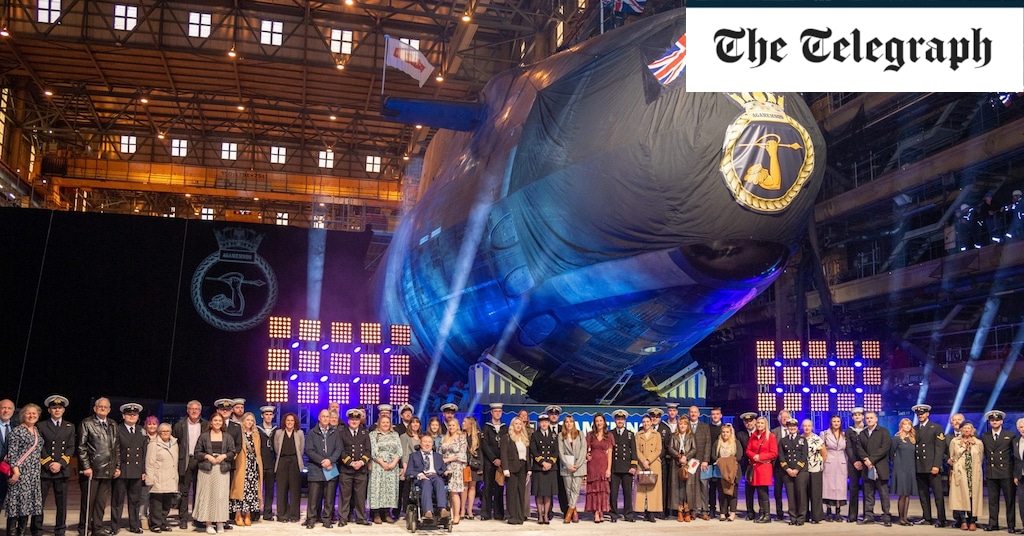
Agamemnon: the Royal Navy’s latest submarine is named
The vessel is equipped with world-leading sensors and can manufacture its own oxygen and fresh water from the sea
Scott Kenny
ACCESS: USAP
- Joined
- 15 May 2023
- Messages
- 11,668
- Reaction score
- 14,385
As I understand it, the hard chine is to help redirect active sonar.
With a cylindrical hull, there is always some part of the hull that is at a perfect 90deg to the sonar signal. Not a very large part, but it's always there.
With a hard chine and angled sections, you end up with most of the hull being at an angle to the active sonar emitter and bouncing the sound away from the receiver. Yes, if you are at the perfect spot you have a huge flat plate 90deg to your sonar beam, but by then you're within a mile or less of the sub anyways.
Same reason the US Army Cobra helicopters got flat canopies in Europe, so that there'd be a small number of places where the canopy would glint in the sun instead of basically always glinting with a round canopy.
With a cylindrical hull, there is always some part of the hull that is at a perfect 90deg to the sonar signal. Not a very large part, but it's always there.
With a hard chine and angled sections, you end up with most of the hull being at an angle to the active sonar emitter and bouncing the sound away from the receiver. Yes, if you are at the perfect spot you have a huge flat plate 90deg to your sonar beam, but by then you're within a mile or less of the sub anyways.
Same reason the US Army Cobra helicopters got flat canopies in Europe, so that there'd be a small number of places where the canopy would glint in the sun instead of basically always glinting with a round canopy.
Rhinocrates
ACCESS: Top Secret
- Joined
- 26 September 2006
- Messages
- 3,054
- Reaction score
- 7,789
I guess too that the overall relatively pointy nose and heavy rear rather than the teardrop are to maintain laminar flow. Barnes Wallis' Heydey rocket torpedo used this principle. The sail shows it quite clearly and you can see that its widest point is well back. Note the rather extreme narrowing towards the pumpjet versus the taper on a Virginia. This is also characteristic of laminar flow optimised designs.
The advantage is that you have less chance of cavitation or turbulent flow and thus a quiet boat. The disadvantage is that you have to manage a complexly varying cross-section along the whole length and you can't simply plonk a new cylindrical section in, as has been and will be done with the Virginias (first in the bow and soon midships with the Block Vs).
The advantage is that you have less chance of cavitation or turbulent flow and thus a quiet boat. The disadvantage is that you have to manage a complexly varying cross-section along the whole length and you can't simply plonk a new cylindrical section in, as has been and will be done with the Virginias (first in the bow and soon midships with the Block Vs).
Attachments
Last edited:
Rhinocrates
ACCESS: Top Secret
- Joined
- 26 September 2006
- Messages
- 3,054
- Reaction score
- 7,789
Rhinocrates
ACCESS: Top Secret
- Joined
- 26 September 2006
- Messages
- 3,054
- Reaction score
- 7,789
To be noted that TKMS with the newer Type 212 CD/E hull they use a hard chine, they call it their Diamond Shape.As I understand it, the hard chine is to help redirect active sonar.
With a cylindrical hull, there is always some part of the hull that is at a perfect 90deg to the sonar signal. Not a very large part, but it's always there.
With a hard chine and angled sections, you end up with most of the hull being at an angle to the active sonar emitter and bouncing the sound away from the receiver. Yes, if you are at the perfect spot you have a huge flat plate 90deg to your sonar beam, but by then you're within a mile or less of the sub anyways.
Same reason the US Army Cobra helicopters got flat canopies in Europe, so that there'd be a small number of places where the canopy would glint in the sun instead of basically always glinting with a round canopy.
Screenshot taken from Naval News video on TKMS bid for the Future Dutch Submarine a year ago.
Attachments
Last edited:
WatcherZero
ACCESS: Top Secret
- Joined
- 22 May 2023
- Messages
- 831
- Reaction score
- 1,939
Also seen on the under construction Swedish Blekinge-class which has a gentle chine starting behind the bow getting gradually more pronounced as it progresses towards the aft. Its not in the steel which is perfectly cylindrical, so the shaping must be formed entirely by varying the thickness of its tiles.
(Astute a combination of non cylindrical hull and then tiles to amplify the shaping even further)
(Astute a combination of non cylindrical hull and then tiles to amplify the shaping even further)
Last edited:
Scott Kenny
ACCESS: USAP
- Joined
- 15 May 2023
- Messages
- 11,668
- Reaction score
- 14,385
Or they're using some thin steel for the angles and laying tiles on top of that. Like the turtleback on the back of an Ohio class. Almost all of that is pretty thin steel with ribs and stringers behind it to hold the shape, it free-floods in the area between the pressure hull and the turtleback.Also seen on the under construction Swedish Blekinge-class which has a gentle chine starting behind the bow getting gradually more pronounced as it progresses towards the aft. Its not in the steel which is perfectly cylindrical, so the shaping must be formed entirely by varying the thickness of its tiles.
(Astute a combination of non cylindrical hull and then tiles to amplify the shaping even further)
Contrary to my arguments in that thread, I treated myself to this book last year:
... and was not disappointed! Although I can definitely relate to Hood's comments on Friedman's sometimes tiring style of writing, there are lots of interesting pieces of information. One stand-out example is how tightly RN surface and nuclear submarine ASW ops were supposed to be intertwined via acoustic datalinks early on, another the confirmation of my earlier hunch regarding sonar configuration and bow shape.
Although I highly recommend it if you have a deeper interest in British post-WWII submarines, it so happens that you don't even need to buy the book to read about it. At some point, this neat website surfaced (see what I did there?) which gets the essential facts across:
 rnsubs.co.uk
rnsubs.co.uk
Here's the relevant image, note that the array installation migrated to the bottom of the bow in later classes (Dreadnought/Valiant/Churchill config shown) to improve performance against deep-diving targets and take advantage of bottom-bounce:

Along with the relocation, the sharp chine and mid-ship torpedo tubes were introduced, but the sonar window shape was always the same single-curvature panel as it is today.
... and was not disappointed! Although I can definitely relate to Hood's comments on Friedman's sometimes tiring style of writing, there are lots of interesting pieces of information. One stand-out example is how tightly RN surface and nuclear submarine ASW ops were supposed to be intertwined via acoustic datalinks early on, another the confirmation of my earlier hunch regarding sonar configuration and bow shape.
Although I highly recommend it if you have a deeper interest in British post-WWII submarines, it so happens that you don't even need to buy the book to read about it. At some point, this neat website surfaced (see what I did there?) which gets the essential facts across:
The History Of British Submarine Sonars
Titanic. The name of this famous ship (or infamous, depending on the way you look at history) reverberates throughout the century since she sank in 1912. Her sinking was the instigator of many changes, developments and innovations not least the genesis of the US Coast Guard and SOLAS. Among the...
Here's the relevant image, note that the array installation migrated to the bottom of the bow in later classes (Dreadnought/Valiant/Churchill config shown) to improve performance against deep-diving targets and take advantage of bottom-bounce:

Along with the relocation, the sharp chine and mid-ship torpedo tubes were introduced, but the sonar window shape was always the same single-curvature panel as it is today.
Type 212 is essentially a double-hull design anyway, due to the external hydrogen and oxygen storage tanks for its AIP. Since the outer hull does not need to bear pressure loads, it is free to be shaped according to other requirements, in this instance acoustic stealth.
Scott Kenny
ACCESS: USAP
- Joined
- 15 May 2023
- Messages
- 11,668
- Reaction score
- 14,385
Exactly.Type 212 is essentially a double-hull design anyway, due to the external hydrogen and oxygen storage tanks for its AIP. Since the outer hull does not need to bear pressure loads, it is free to be shaped according to other requirements, in this instance acoustic stealth.
Any place you don't have to take test depth pressure, you shape for other reasons.
Scott Kenny
ACCESS: USAP
- Joined
- 15 May 2023
- Messages
- 11,668
- Reaction score
- 14,385
Sting Rays are lightweight torpedoes, not 21" heavyweights. Spearfish is the Astute-class' weapon.
BAE Systems secures contract to upgrade Sting Ray torpedoes for Royal Navy - Naval News
The Ministry of Defence has awarded BAE Systems a £60 million contract to upgrade the Royal Navy’s autonomous Sting Ray lightweight torpedo.www.navalnews.com
aonestudio
I really should change my personal text
- Joined
- 11 March 2018
- Messages
- 2,966
- Reaction score
- 7,497
Rhinocrates
ACCESS: Top Secret
- Joined
- 26 September 2006
- Messages
- 3,054
- Reaction score
- 7,789
I assume that the RN has the good sense not to name the next boat in the class the HMS Aegisthus.

 en.wikipedia.org
en.wikipedia.org

Agamemnon - Wikipedia
WatcherZero
ACCESS: Top Secret
- Joined
- 22 May 2023
- Messages
- 831
- Reaction score
- 1,939
I assume that the RN has the good sense not to name the next boat in the class the HMS Aegisthus.

Agamemnon - Wikipedia
en.wikipedia.org
No, never been an Aegisthus but there has been several HMS Orestes.
Similar threads
-
-
-
Royal Navy submarine special forces delivery systems
- Started by Pirate Pete
- Replies: 3
-
-

